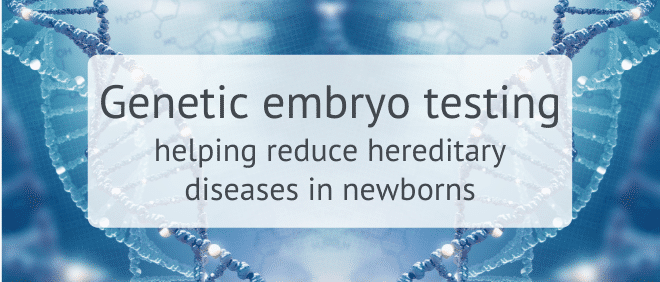

Research suggests that 30 per cent of children’s hospital admissions are due to genetic disorders, however with the help of advanced preimplantation genetic testing of embryos, the number of children born with these genetic diseases can potentially be reduced*.
Genetic embryo testing can assist patients with a family history of a monogenic or single gene disorder who are therefore at risk of producing embryos affected by the condition.
This type of genetic testing (undertaken in conjunction with IVF) carried out in specialist laboratories is called Pre-implantation Genetic Testing for monogenic (single gene) defects (PGT-M).
PGT-M is available for the majority of serious genetic conditions and is recommended if a patient wants to test for a known genetic disease they may have or be a carrier of. Patients will receive counselling from a clinical geneticist before undertaking PGT-M.
Some of the more commonly known single gene disorders tested for include Cystic Fibrosis, Beta-thalassaemia, Thalassaemia, Spinal Cerebral Atrophy and Spinal Muscular Atrophy; and BRCA1/BRCA2 (hereditary breast and/or ovarian cancer).
What method is used?
At City Fertility we employ the most advanced genetic testing method currently available called Next Generation Sequencing (NGS). NGS is an extremely sensitive testing method with the analysis including several hundred thousand readings for each chromosome.
A small number of embryonic cells are removed from the embryo or egg by the following method:
Blastocyst trophectoderm Biopsy: some trophectoderm cells are carefully removed on the fifth or sixth day of embryo development (Blastocyst stage) for testing.
How are the cells tested?
After biopsy, the removed cells are placed in a small test tube and sent to the dedicated Genetics lab. The Deoxyribonucleic acid, more commonly known as DNA (complex molecule that contains all the information necessary to build and maintain an organism – including hereditary material), in the embryonic cells is then processed and amplified (replicated). Analysis of the DNA will give the genetic information for each embryo tested and identify if they are carriers or are affected by the condition being tested for.
What happens next?
While the PGT testing of the cells is taking place the embryos are frozen and kept in storage. Once the testing is complete and if a preferred unaffected embryo is identified, it is then thawed and transferred into the prepared uterus in a frozen embryo transfer cycle.
What are the associated risks?
The associated risks of the embryo biopsy procedure are low. The risk of accidental damage to an embryo during removal of the cell(s) is less than 1%.
The chance of biopsied cells (per cycle) not yielding a test result is less than 2%. These embryos can still be transferred, but the advantages of PGT do not apply.
PGT-M testing can occur concurrently with Preimplantation Genetic Testing for aneuploidy (PGT-A) which looks at the chromosomal makeup of the embryo to identify chromosomal abnormalities.
As PGT testing is a screening test, we recommend prenatal testing to confirm results.
City Fertility offers patients the latest in genetic testing with the use of PGT genetic testing
This Friday (6 August) is Jeans for Genes Day which aims to raise funds to support research into finding treatments and cures for serious genetic conditions affecting Australian kids. For more information or to donate visit fundraise.jeansforgenes.org.au/.
For more information on genetic testing at City Fertility visit our genetic-testing page.
* https://fundraise.jeansforgenes.org.au/about







